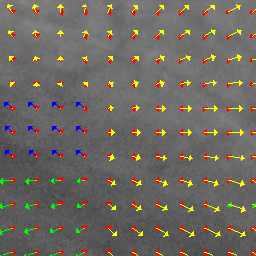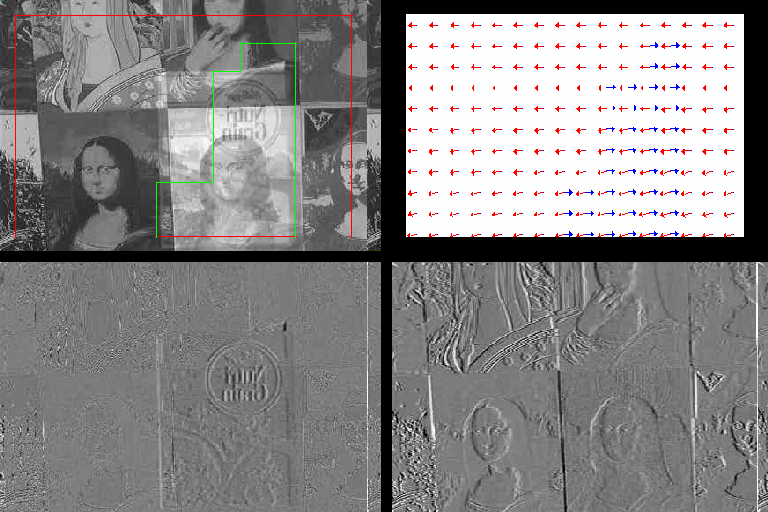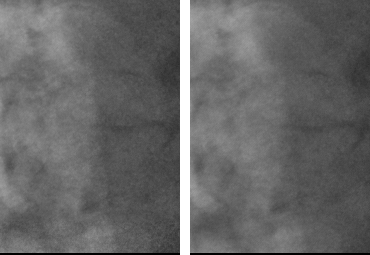Vincent Auvray - Contributions
(Back)
Quick insight of the transparent motion estimation
Three main approaches are proposed in the litterature to estimate transparent motions:
Partial adaptation of classical motion estimators (Black and Anandan, Irani and Peleg), but for partial transparencies only.
Detection of planes in the 3D Fourier space (Shizawa and Mase, Pingault and Pellerin, Stuke and Aach),
but it must assume that motions are translationals over dozen of frames.
Transparent motion estimation in the direct space (Pingault and Pellerin, Stuke and Aach, Toro), which relies on an
equation equivalent for the brightness consistancy. For two layers:
It assumes that the motions are constant over two successive time intervals.
Our contributions belong to this last class of approches. (More)
Our contributions in bitransparent configuration
In a first time, we have developed a synthetic image generation process which follows the physics of X-Ray
image formation. That allows us to compare our estimates to a known ground truth.
(More)
We have developped three generations of motion estimators dedicated to the bitransparency. This refers to a transparency
made of two layers over the image. (And two layers only!)
Our first contribution (presented to ICIP'05) did not allow us to reach an estimation accuracy
good enough on clinical sequences with a realistic noise.
This is why we imagined a second algorithm, presented at MICCAI'05. To be as robust to noise
as possible, we tried to constraint the problem as much as we could. Many real exams observations convinced us that the anatomical
motions (heart beating, lungs dilation, diaphragm translation) could be modeled with affine displacement fields.
This approach allows for precisions of 0.6 and 2.8 pixels on images typical for diagnostic and interventional images respectively.
We finally proposed in ICIP'06 an evolution of this algorithm, reaching precisions of 0.6
pixels on diagnostic images and 1.2 on fluoroscopic images, and presented real examples.
(More)(Demos)
 Estimated motion fields on a part of cardiac exam in situation of bi-transparency.
Estimated motion fields on a part of cardiac exam in situation of bi-transparency.
Our contributions in bidistributed transparency
Our contribution until that point estimated the transparent motions present in a sequence showing one configuration only:
two layers having coherent motions were present over the whole image. Most of the contribution on this topic refer to this
situation.
Now, the real images are more complex: they contain more that two layers overall, but rarely more than two locally. Which is why
we have introduced the concept of bidistributed transparency to account for images that can be segmented in areas
containing one or two layers.
 Fluoroscopic exam image, that can be segmented in an area heart+lungs, heart+diaphragm, heart+spine, etc.
Fluoroscopic exam image, that can be segmented in an area heart+lungs, heart+diaphragm, heart+spine, etc.
Our observation of real sequences showing that a large majority of clinical exams results in images of this kind, we have developed
an approach to process them, which will be presented in ICIP'06. The idea is to separate
the input sequence in its different two-layers area, and to process them with the previous method.
More precisely, we propose a joint motion-based segmentation and motion estimation technique, presented in a Markovian
formalism. To determine both the velocity fields and the corresponding blocks labeling, we minimize an energy made of a data-driven
term based on the fundamental equation of the transparent motion presented above, and a smoothing term. It is iteratively minimized
using the Iterative Reweighted Least Square method to estimate robustly the parameters of the motion model when the labels are fixed,
and the ISM technique to estimate the labels once the motion parameters are fixed. Such a method is fast and reliable if correctly initialized.
To do so, we resort to a transparent block-matching followed by the fields extraction with the Hough transform.
This algorithm leads to precisions of 0.6 pixels on diagnostic images and 1.2 on fluoroscopic images.
 Two images for a fluoroscopic sequence, the estimated motions (the field corresponding to the background is worth
zero and thus invisible) and the resulting segmentation.
Two images for a fluoroscopic sequence, the estimated motions (the field corresponding to the background is worth
zero and thus invisible) and the resulting segmentation.
 Processing of a video sequence in a situation of bi-distributed transparency. Top left: the segmentation in layers,
top right the estimated motions, and on the bottom the compensated difference images.
Processing of a video sequence in a situation of bi-distributed transparency. Top left: the segmentation in layers,
top right the estimated motions, and on the bottom the compensated difference images.
We present above an example of estimation on clinical images, and a sequence of results on a video sequence with transparency.
It pictures a corn-flakes box reflected on the frame covering a Mona-Lisa patchwork. In both cases, segmentations and estimations
match the observation. We also present the sequence of compensated differences on the video sequence. It proves that T=the motion
estimation is correct since the corresponding layer disappears.
(Back)
We also present a demo, showing the different stages of motion estimation.
Application to denoising
We also need to know how to use this motion information to denoise our sequences. We have proposed an original framework to do so
in MICCAI'05.
. It yielded a very disappointing asymptotic deoising of 20%.
(More)
We have therefore developed the so-called hybrid filters, which decide locally between different possible motion compensations:
Transparent motion compensation when both layers are textured.
Compensation of the motion of the more textured layer in any other case (one layer only is textured, or both layers are homogeneous). This way,
we preserve the useful information without impairing the achievable denoising power.
This approach can be used both in purely temporal denoising filter, as well as in spatio-temporal denoising filters. In the former case, we achieve
a denoising of about 50% (in standart deviation), without useful information blurring (submitted to ISBI'07).
 Fluoroscopic sequence processing with the temporal hybrid filter (left) and a classical adaptative temporal filter (right).
The heart is much more contrasted on the left for an equivalent denoising.
Fluoroscopic sequence processing with the temporal hybrid filter (left) and a classical adaptative temporal filter (right).
The heart is much more contrasted on the left for an equivalent denoising.
Back




